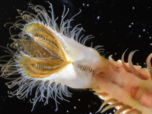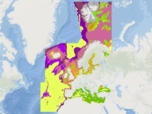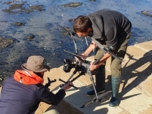Modelling and spatial dynamics of benthic habitat distribution
Spatial dynamics are analysed through multiple approaches. Imagery (acoustic, airborne, satellite) from different signals (Sonar, Lidar, multi and hyperspectral censors) are analysed in a manner which allows the examination and classification of the nature of habitats, as well as a spatialisation of physical and biological information, at scales ranging from centimetres to tens of kilometres.
Within these novel acquisition methods, the team is invested in techniques allowing data acquisition at a high spatio-temporal resolution, such as through the use of drones. This multipurpose tool can for example be used to follow the 3-D structure of biogenic reefs, or to map seagrass meadows.
The team has recognised expertise in statistical distribution models: it had produced regional-scale seabed habitat maps, as part of European projects or in response to marine policy requests. Through combining groundtruth data with image analysis and physical model outputs, fine-scale foundation species distribution models (eelgrass, kelp, maerl and coral reefs) have also been produced. Changing scales is in fact an area of research in itself the team focuses on.
Species, community and/or habitat modelling is a defining skill of the team. It allows us to analyse and classify the dominant processes and explanatory variables, but also to draw up future scenarios and predictions of potential community evolution, for example in response to local environment modification, or to global modification (as is the case with climate change). Several team projects use future climate scenarios to predict the response of species or habitats.
In addition, deterministic modelling is used to study species distribution, where biological relationships are formalised into processes based on underlying ecological theory. These models therefore join together, in varying degrees of complexity, hydrodynamics, primary production, population dynamics and organism ecophysiology. The physiology of organisms is covered by a bio-energetic approach based on the Dynamic Energy Budget (DEB) theory.
Ultimately, predictive modelling developed in the team aims to estimate the distribution of certain habitat or species as a function of physical, chemical, hydrodynamic or biological models. This modelling is considered mixed when using advanced statistics (correlative or Bayesian approaches), or when integrating formalised biological processes.













